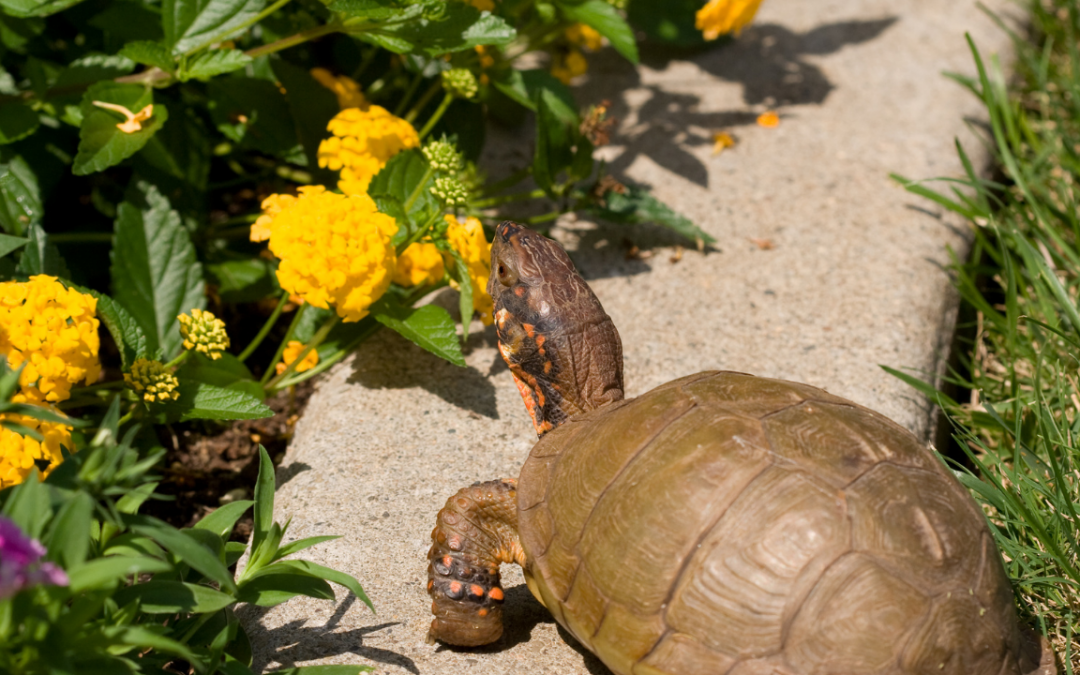Table of Contents
Turtles are another animal that is great for petting. They are the most popular reptiles kept as pets in the United State and are continuously making a rise in other parts of the world. They are fascinating, friendly, harmless and you will surely adore how they behave and how they often perform silly cute movements. If you are planning to own one, which I think you must, or is a complete beginner on how to raise a box turtle. Learning how to feed them, effectively and safely; here are the fave feeders for box turtles:
Foods that Box turtles love and are best for them!
Box Turtles are regarded as omnivores. Their diet should be a mixed healthy amount of fruits, vegetables, and meat for maximizing their health and well-being.
Ideally, your box turtle diet should have almost seventy percent of vegetables in it. Not only do they contain a tremendous amount of health benefits and nourishment your box turtle needs, but also to copy their natural diet as much as possible, since we know that box turtles generally live in the wild.
These are great choices of vegetables to feed them:
- Kale
- Collard greens
- Mustard greens
- Romaine lettuce
- Chinese and green cabbage
- Swiss chard
- Dandelions, their stems, leaves and flowers
- Pea pods
- Green peas
- Beets
- Shredded carrots
- Shredded squash
Vegetables to be best fed occasionally
- Spinach
- Broccoli
- Corn
- Cucumbers
Flowers to be best fed occasionally
- Hibiscus
- Rose petals
- Geraniums
- Nasturtiums
- Carnations
- Lilies
- Pansies
- Petunias
- Borage
Fruits should make up almost fifteen percent of their diet. Fifteen percent only because fruits do not give that much of nutrients, vitamins, and minerals that vegetables give, which is really vital for your box turtle’s health and well-being.
These are great choices of fruits to feed them:
- Banana
- Melon
- Apples
- Kiwi
- Mixed Berries
- Mangos
- Papaya
- Grapes
- Tomatoes
- Peaches
- Apricots
Fruits best to be fed occasionally
- Watermelon
- Cherries
- Strawberries
As for the remaining fifteen percent, these will account for a protein that is to be found in insects, worms, and selected meats. Protein will secure optimum health for your box turtle.
These are great choices of sources of proteins to feed them:
- Earthworms
- Red worms
- Wax worms
- Slugs
- Snails
- Crickets
- Grasshoppers
- Beetles
- Eggs
Meats to be best fed, in small amounts
- Cooked fish
- Cooked chicken
Great sources of calcium are necessary for a box turtle’s strong shell. Best added to your turtle’s regular diet, feeding it in small amounts is a must.
- eggshells
- oyster shells
- cuttlebone
Lean towards these food choices and will guarantee you that your box turtle should be lively and healthy. Remember to feed these food choices clean and properly prepared.
Foods Box Turtles Hates
Box turtles tend to dislike foods that are generally made for humans and do not mimic foods that are generally to be found in the wild. Just as:
- Hamburgers
- Pizzas
- French fries
- Pastries
- Processed foods i.e. junk foods
Not only are they unhealthy, but it is also really best to avoid them at all cost because we might enjoy it as humans, they see them as something not appealing and would just harm them.
Foods that are bad for your Box turtles
It is obvious that generally, they lean towards foods that mimic nature as much as possible, so therefore, we might assume that they can endure any food that is available, but there are a great number of foods that we should avoid feeding them as well, to keep them safe and at optimum health and wellness.
Listed below are certain foods to never feed your box turtle. These are the most popular, known, and most accessible to humans. Do further research for the full comprehensive list.
- Potato plant
- Tobacco plant
- Avocado peel, seeds and leaves
- Tomato leaves and vines
- Poison Ivy
- Asparagus fern
- Begonia
- Boston Ivy
- Box wood
- Gardenia
These plants contain toxic compounds that are poisonous to your box turtles. Their effects are intense and have the potential to be fatal.
- Dairy products. It is important to take note that box turtles cannot digest these, and they might lead to critical medical conditions. Avoid giving your turtle cheese, milks, yogurts and any other foods that contain dairy.
- Processed foods. They are generally both bad for us humans, and animals. High salt content can make your box turtle feel sick.
- Candies. They are not nutritious in any way, shape or form. They might be enjoyable for humans, but it does not give any enjoyment, more importantly any healthful benefits to our box turtles.
- Junk Foods. They are not nutritious in any way, shape or form. They might be enjoyable for humans, but it does not give any enjoyment, more importantly any healthful benefits to our box turtles.
Conclusion
One of the most crucial foundations of raising a lively, healthy, long lifespan box turtle is the nutritious foods they obtain every single day of their lives. That is why it is really important to be knowledgeable about their diet.
With proper diet, utmost care, and love together with regular visits to their veterinarian, we ought to raise box turtles effectively, and with only these, we can call ourselves effective and responsible pet owners.
Do not deprive your box turtles of the opportunity to live and lead a happy and healthy life! Tune in more for articles that will benefit your pet ownership.
Box Turtle: Beginner’s guide to knowing them
Do you get curious about how box turtles live their lives? How do they behave? What are the things that are common for them? And if you want to be their pet owner, what are the essential facts, together with basic caring you must know? Let’s explore them together.
Unboxing the Boxed Turtles!
Box turtles are reptiles belonging to the family of marsh turtles
They are native turtles of North America and are a growing popular pet turtle. In the wild, box turtles live in woodlands, pastures, floodplains, grasslands, meadows, and near a stream or a pond.
Box turtle sizes can grow up to eight inches
They have an elevated upper part of the shell (domed carapace) and a hinged lower part of the shell (plastron) that allows them to have complete closure of their shell. In terms of their appearance, their shells are brown in color and mostly covered in spots, lines, blotches, and bars.
Male box turtles are larger than the female ones
Males have thicker tails, they have red eyes and their claws are short and curved. They have a concave plastron. Females have yellow eyes, with claws that are long and straight. They have a convex plastron. Box turtles are diurnal animals, meaning they are active during the day
Box turtles are omnivores
Their diet requires seventy percent made up of vegetables, fifteen percent making up of fruits, and the remaining fifteen percent are proteins and safe meats for them. Box turtles, when they have eaten poisonous plants, retain their toxins to their body. This can be fatal in the long run or they can induce it in their owners.
Box turtles have soft shells until their seven years of life
It makes them vulnerable prey to raccoons, dogs, minks, and snakes. Box turtles have a mellow personality. They are quiet but are social creatures in their own distinct way. They are able to recognize the sound and the appearance of their favorite humans and will plead for playtime and food.
To entertain them, you can play with your box turtle in the sun, they have natural sunlight and they are fascinating when observing them. They also love a good bath, more of a swim. This will relax them after a good sunbathing, also keeping them clean whilst being happy.
They love to have lap times with their owners
A great relaxing bonding is by allowing them to sit on your lap and gently pet the top of their head, chins, and cheeks, their shells, and they, in some instances, enjoy a gentle neck massage.
Patience is a virtue, when you are wanting for your box turtle to like you
This is because naturally, they live their lives in the wild, and adjusting to humans can sometimes be viewed as threatening, intimidating, and challenging. Rest assured that once they feel safe in your presence, your relationship with each other will be a lot easier, better, and happier. Box turtles can survive up to a hundred years in the wild, but their average lifespan is thirty years.
Basic Caring for Box Turtles
- Box turtles thrive best in turtle safe outdoor pens that imitate their natural habitat. It should be at least eighteen inches tall with an overhang that will prevent box turtles from escaping. They should have sunny and shady areas, places where they can hide to feel secure, access to food and water and they should be built with protection from predators, and disclose their pens with wire mesh, since their shells are vulnerable especially when they are young.
- They require natural sunlight, of at least twelve hours a day to metabolize the calcium to their bodies. Without it, they might develop a metabolic bone disease that can be fatal. When you are planning to raise them indoors or if the sun is not out, it is best to have a UVB lighting since it also does its job.
- Feeding them should be your top priority. They are considered omnivores. Their diet should be varied, with a great amount of vegetables, fruits and protein that is often in the form of insects, or worms. Provide them with clean water as well. Feeding is one of the foundations of how healthy your pet turtle is going to be, and how long they can live. For proper feeding proportion, consult your veterinarian.
- Spend time with your box turtle. Do not raise them just because it is popular and because you want them to be displayed in your house. They are social creatures that love human connection and companionship. They strive best when they have a loving environment around them. Play, unwind, relax and overall give love and affection to your box turtle, they will also love you in return.
- Consult their veterinarian regularly. This is to optimize their health and well being. This is helpful if your box turtle is masking pain, or if they have undiagnosed diseases, veterinarian will help in treating them.
Conclusion
Keep in mind that Box turtles are a great pet to have, it is even a fulfilling one since you learn how to really raise them in the right and safe manner since they require comprehensive care. I hope that these beginner facts and basic caring instructions help, and even persuade you to start your box turtle petting journey. Remember that responsible pet ownership, together with love, affection, and care raise a lively, happy and healthy lovable pet.






 Author and long-time animal lover. Sharing knowledge on pet care through experience and the written word.
Author and long-time animal lover. Sharing knowledge on pet care through experience and the written word.